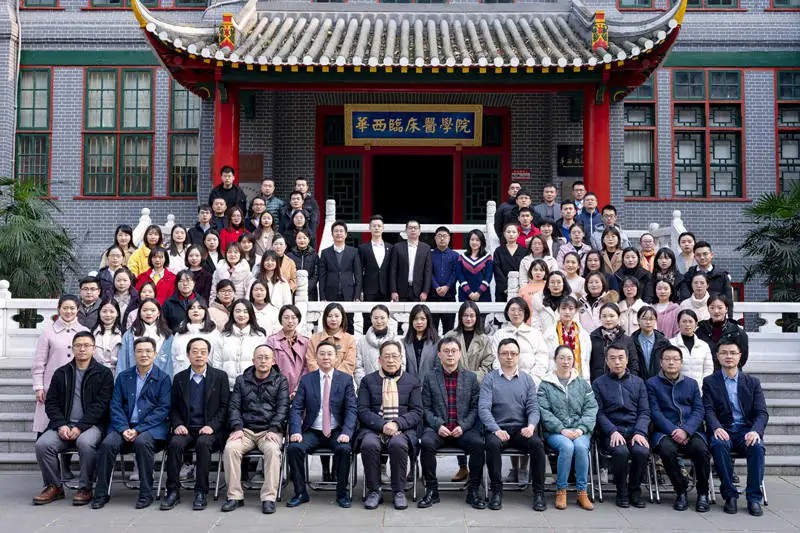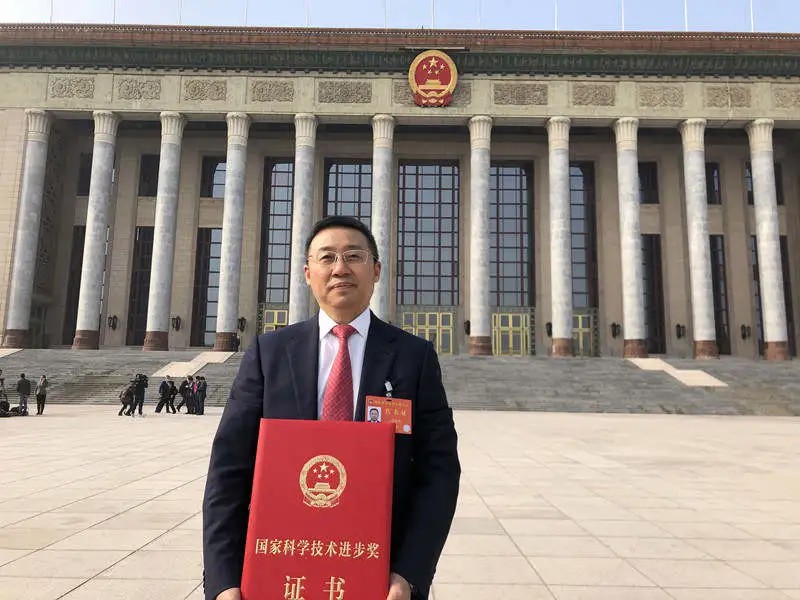Professor Li Weimin’s Team of West China Hospital of Sichuan University Wins the Second Prize of National Science and Technology Progress Award

Open the phone and scan

Established a series of early screening, early diagnosis and early treatment technologies, increasing the early diagnosis rate of lung cancer from 26.48% to 60.78%; developed artificial intelligence products to quickly detect 3-5mm lung nodules, with an accuracy of 98.8%; established a technique of percutaneous puncture to acquire a small sample of tissue used for lung cancer gene mutation detection, with an accuracy rate of 95.45%...
On November 3, the Central Committee of the Communist Party of China and the State Council solemnly held the 2020 National Science and Technology Awards Conference in Beijing. The “Establishment and Clinical Application of Key Technologies for Early Accurate Diagnosis of Lung Cancer”, led by Professor Li Weimin from the Department of Respiratory and Critical Care Medicine, West China Hospital of Sichuan University, won the second prize of the 2020 National Science and Technology Progress Award.
Since 2001, Professor Li Weimin and his team have been committed to basic research and clinical transformation of lung cancer. They have carried out scientific and technological research, established an early screening and early diagnosis system, and made breakthroughs in diagnosis and treatment. As a result, they have achieved major theoretical innovations and technological breakthroughs, and realized the goal of “double improvement” of the early diagnosis rate of lung cancer and the 5-year survival rate.

· Why target the early screening and early diagnosis of lung cancer?
Compared with the 5.8% survival rate at the advanced stage, the 5-year survival rate at the early stage is more than 92%.
“There was a 44-year-old female patient who found a thin 2.5mm nodule shadow during physical examination in 2013 and was not diagnosed at that time; the diameter of the nodule increased to 7mm during the reexamination in 2014, but it was not treated for various reasons; in 2015, it grew to 27mm and it was confirmed pathologically to be adenocarcinoma after lung cancer surgery. When re-examined 2 years later, it was found to have spread to both lungs, with an extremely poor prognosis.” Li Weimin said, “If she treated it when the nodule was enlarged during the first reexamination in 2014, then her prognosis would be very good” , noting that the 5-year survival rate of early lung cancer in fact can reach 92% or more, but the survival rate of advanced lung cancer is only 5.8%. The painful lesson of this patient drive Professor Li Weimin to focus on early screening and early diagnosis of lung cancer.
· How to determine the scope of early screening and early diagnosis? It is necessary to pay attention to the high-risk population for lung cancer screening, but how to determine this population?
At present, the United States and European countries consider heavy smokers over 55 years old as a high-risk group of lung cancer. However, data shows that the high-risk group of lung cancer in China is gradually getting younger, and the proportion of non-smokers with lung cancer is close to 50%, and that of lung cancer patients less than 40 years old and less than 55 years old are13.2% and 56.7%, respectively. If we copy foreign screening guidelines, more than 90% of lung cancers will be missed.
So why is there such a big difference between China and foreign high-risk groups of lung cancer? Are there specific molecular characteristics? Based on this, Professor Li Weimin’s team conducted in-depth studies on lung cancer patients’ families, and discovered and confirmed 6 new susceptibility genes including two new oncogenes PROM1 and CRTC2, and BPIFB1, the new fusion mutant genes in young non-smokers with lung cancer. These genes have been included into “East Asian Lung Adenocarcinoma Genome Atlas”, which has further confirmed the specific molecular characteristics of lung cancer patients in China.
For this reason, the team proposed that low-dose helical CT (LDCT) should be used for lung cancer screening for people over 40 years old, and they innovatively used mobile CT scanners to screen more than 31,500 people in Mianzhu, Longquanyi District and Pidu District of Chengdu, Ganzi and other places in Sichuan. Eventually, more than 200 cases of early-stage lung cancer were screened out. The project team then established a three-level coordination system of West China Hospital-County-level Hospitals-Communities under the support of 5G information platform and image cloud. In this way, experts from West China Hospital could technically support the diagnosis and treatment plans for county-level hospitals and community doctors, and a regional pulmonary nodule/lung cancer whole-process management ecosystem of West China Hospital is established, which has promoted the early standardized screening of lung cancer.
Therefore, the results of this study define the high-risk population of lung cancer as ≥40 years old, with any one of the risk factors (smoking and previous smoking, chronic lung disease, environmental or occupational exposure, family history of lung cancer, etc.). To screen this population by LDCT has been written into the “Consensus of Chinese Experts on Lung Cancer Screening and Management” and included in the “Healthy China Action” plan.

· How to solve the problem of missed diagnosis of early lung cancer?
AI-assisted diagnosis of lung cancer (pulmonary nodules), with a detection accuracy of 98.8%.
Nowadays, hospitals at all levels are increasingly well-equipped, but are the nodules detected by the equipment in the early stage all lung cancer? How to accurately diagnose? How to break the bottleneck of missed diagnosis of early lung cancer?
Professor Li Weimin’s team innovated imaging omics technology and artificial intelligence technology, and overcame the technical difficulties of early, accurate diagnosis of lung cancer by establishing a clinical resource database. Through integration and extraction of clinical, imaging, pathological, genetic and other multi-dimensional data systems, a large-sample intelligent database of 41,574 clinical lung cancer cases has been built to provide big data foundation for the development of new imaging technologies.
At the same time, the team excavated the digital information of CT images, extracted 485 features such as lesion texture, wavelet, shape, and intensity, and correlated them with clinical, pathological and genetic information, etc., and constructed a non-invasive lung cancer diagnosis and prediction model based on imaging omics technology to improve prediction accuracy.
With the support of big data and the prediction model, the team has further developed an AI-assisted diagnosis system for lung cancer (pulmonary nodules), which can realize nodule location & identification and qualitative auxiliary diagnosis in 1 minute. For detecting 3-5mm pulmonary nodules, its accuracy rate can reach 98.8%, which greatly improves the diagnosis rate of early lung cancers smaller than 1cm.
The system has been used in 155 hospitals across the country including West China Hospital of Sichuan University since 2016. It has not only improved the efficiency of chest CT reading, but also reduced the missed diagnosis rate of small lung nodules, empowering the grass-roots hospitals and contributing a lot to homogeneity in early diagnosis of lung cancer.
· How to promote standardized diagnosis and treatment of lung cancer?
“Defined high risk, standardized screening, systematic evaluation and accurate diagnosis”
Eight years ago, Li Weimin led the team to establish and improve the method for obtaining small lung cancer specimens and the rapid detection path for molecular typing. The intelligent non-invasive prediction of common gene mutations (EGFR, TP53, etc.) through imaging has greatly reduced the time compared to traditional methods. They established a technique of percutaneous puncture to obtain small sample for EGRF, ALK and other gene mutation detection and molecular typing, with an accuracy rate of 95.45%; established a technique of target capture combined with NGS technology to detect ALK fusion gene in liquid biopsy, with the coincidence rate with tissue molecular detection reaching 92%; invented a one-step method for rapid construction of amplicon libraries, and developed a series of tumor liquid biopsy kits...
In order to quickly promote the standardized diagnosis and treatment of lung cancer, in recent years, Li Weimin's team has done as much as they could to race against time.
They took the lead in integrating the chromatin open sequence, genome and transcriptome characteristics to analyze the molecular mechanism of lung cancer evolution, and found that the chromatin open region is significantly associated with the changes in the copy number of lung cancer-related genes and regulates the PI3K/Akt signaling pathway. They managed to depict the chromatin open map of lung cancer, and published their research results in Cancer Res, a well-known international cancer journal. The opinion piece of the journal claimed their results opened a new era of multi-omics research on lung cancer.
In view of the lack of high-sensitivity and high-specificity molecular markers in clinical study, Li Weimin’s team screened and confirmed four molecules including BAI-1 and TSP-1 from the plasma of early lung cancer, achieving a sensitivity of 90% in early lung cancer diagnosis, which is higher than commonly used marker (sensitivity <50%). They obtained 10 invention patents and carried out clinical transformation. At the same time, they found four new circular RNAs (hsa-circ-0077837, etc.) at the RNA level, elevating the accuracy of the diagnosis of lung cancer to 90%.
“We hope the series of technologies for early screening, early diagnosis and early treatment of lung cancer with “defined high risk, standardized screening, systematic evaluation and accurate diagnosis and full-process management” we created through research efforts will be applied to the people more quickly.” Under the leadership of Professor Li Weimin, the team used integrated innovation to increase the diagnosis rate of surgically curable early lung cancer (stage IA1) by 10 times to 11.82% (only 1.1% globally), and the diagnosis rate of stage 1A lung cancer from 26.48% in 2011 to 60.78% in 2018. They only not solved the problem of missed diagnosis of early lung cancer, broke through the technical bottleneck of accurate diagnosis of early lung cancer, but also solved the clinical problem of early molecular typing and targeted therapy of lung cancer, which has strongly promoted the standardized process of accurate diagnosis and treatment of lung cancer in China.


